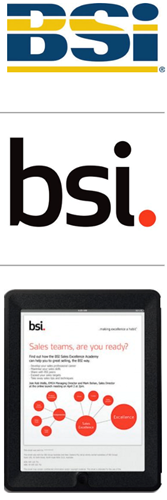
SETTING THE STANDARD
Setting the standard
While repositioning its brand, standards provider BSI addressed its messaging and enlisted SomeOne to revamp its visual identity. Brittany Golob gets the inside story
Standards are a science, not an art. Strict delineations and codes dominate the business of setting standards. A scientist, similarly, must consistently work within the specifically- delineated parameters of the experiment.
BSI, formerly known as the British Standards Institute, dwells in the realm of science. It sets the standard. It determines the parameters. In rebranding BSI’s identity, tone of voice and visual direction, SomeOne has transformed science into art.
BSI sought a change in direction when a new chief executive took the helm four years ago. As part of that plan, the company wished to double the size of its business. Head of brand, Chris Wright, delineates the subsequent five-stage process that began with naught but an idea to echo BSI’s client-facing practices in its internal structure and resulted in a rebrand whose echoes are still rippling through the organisation.
|
Just like the experimenter, developing the hypothesis is one of the first steps to take in solving the problem at hand. The next step is the most crucial: research. It tells the scientist if his question is worth answering. For a business, research can expose weaknesses, points of strengths and inform the leadership of which paths to take in order to answer the initial question. For BSI, the research stage was also that which consequently effected the most change. While BSI is responsible for the establishment and maintenance of manufacturing, service and other standards and accreditations, it is comprised of a contingent of business divisions focused on different industries and different means of doing so. A large portion of those divisions’ core remits is to provide excellent client services and to build relationships with existing or prospective clients. While the company’s reputation was stellar among existing clients, BSI found itself in the difficult position of its corporate communications not matching its client-facing communications. “What we were selling was good, was valued, was worth it, but we needed to do a better job of communicating that in a language that our clients could understand and associate with their businesses,” Wright says. He adds that the existing message of ‘Raising standards worldwide’ explained what BSI did as a business, but it failed to reflect the organisation’s client- first focus. “What the research told us was that we had a strong reputation,” Wright says. “But there was a real potential for us to do more for our clients.” The months of extensive internal and external research also uncovered a fundamental lack of understanding among employees about what the plethora of divisions within BSI actually did. That became a liability when communicating externally as employees were unable to articulate BSI’s value to its clients, Wright says. From the top to the bottom of the organisation and from the United States to Brazil to Italy to Asia- Pacific, months of intensive research proved that BSI’s positioning did not live up to its messaging. Understanding the forces at work within the organisation allowed for scientific precision and objectivity to permeate BSI’s decision-making processes. “It’s important that we have the rigour of that process mapped out and articulated inside the business to help bring the rest of the business with us,” Wright says. “We have a lot of people with a lot of opinions so we needed to make sure we took the subjectivity out.” Research and a scientific approach to objectivity took BSI through to a second stage, in which it defined the positioning that it would espouse both strategically and visually: ‘Making excellence a habit.’ But the company’s verbal repositioning prompted another round of research, this time to determine how BSI’s clients felt about the change. Scientists, with research carried out and hypotheses in place, next move on to experimentation. The trial and error step. This was where BSI would see if its research question would achieve the hypothesised results. It thus introduced the new messaging and communications direction to its clients. In pursuit of scientific precision, the test strapline was delivered to clients free from branding. “It was important that we didn’t distract the research with logos and colour waves,” Wright explains. “You go through research before you get creative in terms of colours and fonts and imagery.” Largely, clients appreciated the new positioning, but it became clear that BSI needed a visual change in direction to match its strategic shift. The data was then analysed and conclusions drawn, as in any experiment. For BSI, the third phase determined whether or not the existing branding would hold up under the new positioning. Rebranding is not always the route a business must take to reposition itself in the marketplace. For a sprawling organisation like BSI, it could have been a matter of tightening up its messaging and communications in order to effect the kind of change it was seeking. However, the internal research and external experimentation proved that a change was necessary. With such a fundamental shift in positioning, Wright says the necessity for a rebrand became evident. In came SomeOne to add a touch of art to the scientific approach the standards institute had taken thus far. “We were brought in post-research and quite rightly,” Gary Holt, co-founder of SomeOne, says. “We wanted to clearly say that BSI stands for something different. The best way of doing that is to get people to reappraise the way they see BSI.” Wright says BSI wanted the new identity to be more modern and approachable, “The identity had to deliver on confidence and surety of thought because what BSI does as a business is deal in fact.” While design was obviously important in telling the BSI story, it took a backseat to the means of delivering BSI’s revamped positioning. “This isn’t a story about the identity, this is a story about the new positioning,” Holt says. “That drove the way the identity looked.” The identity had to be confident, it had to be accurate and it had to be precisely calibrated to the needs of a modern standard bearer. SomeOne fused science together with art in the new branding and developed a clean, approachable, functional logo with a good deal of white space and an ease of flexibility for partners to use and to replicate. Creating an alloy of science and art turned out to be just what BSI’s branding needed. The resulting brand was, according to Holt, “Simple but powerful.” “It had to work in all media,” Holt says. “It had to be based on the research and it had to be both professional and approachable. The identity had to be somewhat design agnostic. If we gave it lots of stripes and sparkly bits then it could clash with other clients and equally, could clash with cultural sensitivities somewhere in the world.” The conclusion of the experimental question, in this case, was that BSI both needed to reposition its communications and to rebrand its visual identity accordingly. SomeOne made that conclusion a reality. The only step that remained was to communicate the experiment’s conclusion to BSI’s audiences. As both clients and employees had been involved in the repositioning from the research stage on, BSI was better prepared for this final stage then are many organisations undergoing a rebrand. Regardless, the company took things slow and rolled out the rebrand internally over the course of six months. All 2,800 staff members went through tone of voice, positioning and messaging training with regards to their particular position within the organisation. “We invested in making sure that our people not only understood what the positioning meant, but could articulate and explain it to their clients,” Wright says. BSI’s value lies in its people. Those people, then, were tasked with selling both the company and the rebrand to its external audiences. The six-month roll out refocused BSI’s internal culture and its external messaging. It consolidated the far-flung pieces of the business behind a common purpose, allowing staff to provide a seamless,recognisable experience to all clients, regardless of industry, division or status. “A rebrand can, when done appropriately, be a rallying cry internally,” Holt says. “It’s a new banner to muster beneath.” The rebrand also pushed through other changes in culture and practice BSI had set out to achieve four years ago and even before. “It acted as a catalyst to drive through things the organisation had been talking about doing for some time.” The rebrand could, as Wright says, “bind them to the change that was going through the whole organisation.” The final step BSI took in its year-long repositioning process was communicating the changes externally – to the clients it polled all those months ago and to the prospective clients that would, hopefully, be persuaded by the change in direction. This involved rolling the rebrand out, gradually again, to all of BSI’s properties, both printed and digital, visual and verbal. “It’s about simplicity and singlemindedness of message,” Holt says of tying the visual identity to BSI’s new positioning strategy. “The identity had to support the message.” The rebrand ultimately encompassed a fundamental shift in strategy, a change in messaging and a new visual identity. But one final issue had to be addressed by SomeOne and BSI – the 110-year-old Kitemark for which BSI is most well-known. The Kitemark, BSI’s primary depiction of industry standards is bestowed upon client organisations along with the newer, yet no less renowned accreditation mark. Both needed to be brought into line with the new outlook. SomeOne slimmed the two marks down and modernised them, but left them largely untouched because of the symbols’ renown and reputation as BSI’s standard bearers. “We haven’t changed the core shape of the BSI Kitemark. It would be foolhardy to change with the recognition and heritage that it has,” Wright says. “We gave it a fresh lick of paint.” BSI’s rebrand was complete. The hypothesis tested and the results analysed. The repositioning communicated within and without the organisation. The experiment concluded. The entire process reflects what BSI fundamentally achieves as a business. It determines what the standard, what the best, is in an industry based on a consensus that represents best practice. In repositioning, BSI implemented research among its audiences, enlisted the assistance of a design agency and determined the consensus of its clients, leaders, staff and consultants in terms of messaging and design in order to create both a revamped system of communications and a rebranded visual identity. |
|
Peer review
Tony Lorenz, strategy and development director at Endpoint
The new positioning ‘making excellence a habit’ is compelling and naturally an organisation that sets the pinnacle in standards wants its own brand promise to set a benchmark. It’s always a challenge to see the promise played out through the brand identity or mark in isolation and it’s in the wider language of the brand’s messaging and behaviours of its internal stakeholders that it will truly achieve success. The Kitemark is in a sense pretty iconic and it is only right that it should be modernised to work in the digital media world we all live in. Visually the brand positioning hits the right notes. However, it’s success in evolving the image and perception of an organisation as brand that cuts through complexity will rest on the effectiveness of its staff embracing the brand vision to create a culture that radiates from the inside out.
Operating in 150 countries with 58 languages and with 65,000 clients, a critical success factor for the new brand to achieve immediate impact will be the need for an orchestrated roll out master plan centred on the right brand assets being prioritised for change and a swift execution across all markets. What the organisation won’t want is the co-existence of two identities that will only serve to confuse the market and fail to deliver the desired impact.




